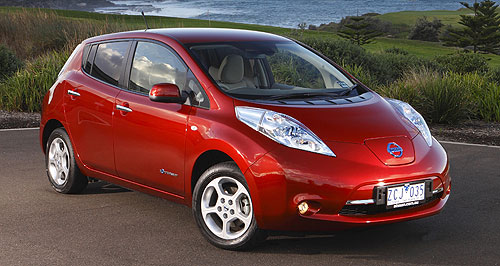Make / Model Search
News - NissanNissan plant survives Aussie auto wipeoutCast in stone: Nissan’s aluminium casting plant in Victoria could end up being the last remnant of global car-making in Australia, thanks to efficiency gains. On death row after the GFC, Nissan Casting Australia is all fired up for the future25 Feb 2014 EFFICIENCY gains including energy savings amounting to $250,000 a year have helped secure the long-term viability of what looks likely to become the last remaining Australian factory run by a major global car-maker. While Ford, Holden and Toyota have all announced the closure of their manufacturing operations in Australia, Nissan Australia says it is business as usual at its aluminium casting plant at Dandenong South, Victoria. It is a rare bit of good news in the Australian car manufacturing industry, meaning job security for 143 full-time workers and 21 casuals that run the plant around the clock on three shifts, six days a week. It marks a significant turnaround from the situation in 2010 when Nissan came perilously close to shutting the then dated, inefficient plant in the wake of the global financial crisis. Nissan Australia managing director and CEO Peter Jones – who will hand over to incoming chief Richard Emery on April 1, but will remain in charge of the casting plant and financial services – told GoAuto this week that the Nissan Casting Australia factory is now running at a profit and that the company has no plans to shut it. The plant, founded in 1982 to supply parts to Nissan Australia’s car manufacturing operations at its Clayton factory that closed in 1991, turns out about two million aluminium components for Nissan vehicles built in several countries, including Japan, Thailand, Mexico and the United States. A new $1.8 million tower furnace – installed last year – replaces three less efficient furnaces in the plant’s aluminium casting operations, helping to stem rising energy costs that had dented the plant’s viability, especially with the extra burden of the carbon tax. A third of the investment – $616,000 – was paid by the federal government under the Clean Technology and Food and Foundry Investment Program. A tower furnace uses up to 50 per cent less energy to melt aluminium by employing the super-heated exhaust gases to preheat the ingots with energy that otherwise would be wasted. Over the 20-plus-year life of the furnace, those savings of up to $250,000 a year will amount to millions of dollars – vital in an energy-critical business. The installation of the furnace follows a $21 million overhaul of the casting operations in 2012 – a project also partly funded by the federal government by a $3.3 million co-investment grant under the now-defunct Green Car Innovation Fund. That investment, along with ground-breaking casting technology developed by Australia’s CSIRO, enabled Nissan Casting Australia to win a global contract to make several complex powertrain castings for Nissan’s all-electric Leaf – a move that then Nissan Australian managing director Dan Thompson said had secured the factory for five years. Mr Thompson told GoAuto at the time that the casting plant had come close to closing in 2010, but a management restructure and focus on productivity improvements had helped to secure the Leaf casting project which involved exporting 22,000 cast aluminium parts a week. Mr Jones said this week that demand for the Australian-made Leaf castings had grown since the first shipments in 2012. “There continues to be a steady growth in the number of parts produced and assembled for the Nissan Leaf EV as sales for this car in existing and new markets continues to grow,” he said. The castings – earning the factory $65 million a year – also include a wide variety of other car parts such as transmission housings, cylinder heads and oil pan assemblies for many Nissan and Infiniti models made in a number of countries. Some of the castings boomerang back to Australia on Nissan and Infiniti vehicles, most of which bear at least one casting with the telltale kangaroo logo of the Dandenong factory. About 95 per cent of the factory’s output is exported, but some parts are made for Albury’s Drivetrain Systems International (DSI) – owned by Chinese car company Geely – which makes and exports automatic transmissions to companies such as South Korea’s SsangYong and India’s Mahindra. As well, the Nissan plant has branched out into accessories such as towbars, aluminium nudge bars and ute sports bars for locally sold Nissan vehicles such as the Navara. Mr Jones said the new furnace was a locally funded project and designed to deliver greater efficiency and reduced environmental impact. He said the carbon tax and the rising cost of energy were important considerations in the project, but “Nissan’s long-term plans were the catalyst for this investment”. “The furnace investment was part of an ongoing productivity and efficiency improvement program, which also includes automation, continuous improvement to tooling, product and processes, inventory reduction, supply chain management and R&D to ensure the plant remains internationally competitive,” he said. “The availability of government funding for the tower furnace was also a consideration and we’re grateful for the generous support given by the federal government for this program. “Likewise, Nissan is also grateful to the Victorian government for their contribution towards the Nissan Leaf EV component supply program.” Mr Jones said the imminent closure of the Alcoa aluminium plant at Geelong, Victoria, would have no affect on the casting operations. He said aluminium used at the plant was sourced from several smelters, but most came from China.  Read more |
Click to shareNissan articlesResearch Nissan Motor industry news |











Facebook Twitter Instagram